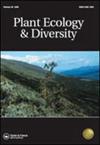潜在自然植被概念与人类世的相关性
IF 1.6
4区 生物学
Q2 PLANT SCIENCES
引用次数: 11
摘要
潜在自然植被(PNV)的概念是指与场地提供的环境条件相匹配的自我维持的成熟植被。尽管这一概念被广泛使用,但在目前人类对环境的影响水平下,这一概念的适用性受到了批评。我们重新审视PNV概念的最初发表及其随着时间的发展,以确定理论与应用之间紧张的根源,并将话语引导到一个共同的理解基础上。我们的重点是人类影响与PNV之间的关系。基于扩展的摘录和详细的解释,我们确认PNV适用于特定的时间点。因此,PNV独立于任何已实现的植被,包括过去未受干扰的(前人类)植被。我们跟踪可能的途径和原因的不同解释。我们认为PNV是一个心理概念,或者是一个中性模型,它代表了基线植被潜力,不包括当代人类管理,但包括过去的环境改变影响。我们讨论了一个反映未管理植被的概念如何在人类改变的世界中发挥重要作用。我们主张坚持按照其定义的原始意义来使用它,而不是放弃这个概念。这样一来,PNV就可以作为一个中立的模型为研究提供服务,并支持可持续的土地利用规划。本文章由计算机程序翻译,如有差异,请以英文原文为准。
The relevance of the concept of potential natural vegetation in the Anthropocene
ABSTRACT Background The concept of potential natural vegetation (PNV) refers to self-sustaining mature vegetation matching the environmental conditions a site offers. Despite its widespread use, the applicability of the concept under the current level of human impacts on the environment has been criticised. Aims We re-examine the original publication of the PNV concept and its development over time to identify the sources of tension between theory and application and to direct the discourse onto a common ground of understanding. Our focus is on the relationship between human impacts and PNV. Arguments Based on extended excerpts and detailed interpretation, we affirm that PNV applies to a specific point in time. Consequently, PNV is independent of any realised vegetation including past undisturbed (pre-human) vegetation. We track possible routes and reasons for alternative interpretations. We identify PNV as a mental concept, or a neutral model, that represents baseline vegetation potential that excludes contemporary human management but includes past environment-modifying impacts. We address how a concept reflecting unmanaged vegetation can be important for application in a world transformed by humans. Conclusions Rather than abandoning the concept, we advocate adhering to using it in the original sense of its definition. This way PNV can serve research as a neutral model and support sustainable land use planning.
求助全文
通过发布文献求助,成功后即可免费获取论文全文。
去求助
来源期刊

Plant Ecology & Diversity
PLANT SCIENCES-
CiteScore
3.30
自引率
0.00%
发文量
26
审稿时长
3 months
期刊介绍:
Plant Ecology and Diversity is an international journal for communicating results and novel ideas in plant science, in print and on-line, six times a year. All areas of plant biology relating to ecology, evolution and diversity are of interest, including those which explicitly deal with today''s highly topical themes, such as biodiversity, conservation and global change. We consider submissions that address fundamental questions which are pertinent to contemporary plant science. Articles concerning extreme environments world-wide are particularly welcome.
Plant Ecology and Diversity considers for publication original research articles, short communications, reviews, and scientific correspondence that explore thought-provoking ideas.
To aid redressing ‘publication bias’ the journal is unique in reporting, in the form of short communications, ‘negative results’ and ‘repeat experiments’ that test ecological theories experimentally, in theoretically flawless and methodologically sound papers. Research reviews and method papers, are also encouraged.
Plant Ecology & Diversity publishes high-quality and topical research that demonstrates solid scholarship. As such, the journal does not publish purely descriptive papers. Submissions are required to focus on research topics that are broad in their scope and thus provide new insights and contribute to theory. The original research should address clear hypotheses that test theory or questions and offer new insights on topics of interest to an international readership.
 求助内容:
求助内容: 应助结果提醒方式:
应助结果提醒方式:


